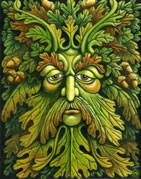|
Legendary IrelandThere is little scientific knowledge about the people who lived in Ireland between the estimated arrival of humans around 7000 BCE and the arrival of the Celtic Gaels around 100 BCE. The archaeological findings and the marks left by these early inhabitants in the landscape do not reveal their origin. Based on the megalithic monuments and earthworks we assume there was some sort of religion and civilisation on Ireland prior to the Gaels, but until know we have no hard evidence to support any idea about the organisation of pre-Celtic Ireland. By the lack of hard evidence we are forced to built our ideas on myths and legends. To keep track of the numerous Irish legends they are classified in four so-called cycles. The purpose of this classification is purely academic. Paganism vs. ChristianitySince time immemorial Irish legends has been passed on from generation by generation by oral tradition. It is very likely that the story-lines has been altered in the course of the centuries and perhaps even millennia. Some of these modernisation's are quite obvious. The appearance of the historical third century CE king Cormac MacArt in the much older Finean Cycle for example. One must assume that Christianisation of Ireland was the ultimate goal of the Church. Just by recording the myths, and therewith demystify the knowledge of the powerful druids, they won the first strike. The most smooth way to achieve large scale conversion was to proof resemblance's between the legends and the Gospels. In order to do so they could have studied the legends to find issues the Gospels could affiliate with or they could twist and bent the legends a bit to fit with the Gospels. By linking the pagan legends to Biblical events the appearance is against the Church. Unfortunately there is no undelete function in the manuscripts, thus we will never know what the monks and the priests thought to be unfit. However, we have to be careful in judging the writers because some modern-day scholars assume an ancestral link between the last mythical tribe, the Milesians, and the Israelites. So perhaps not all similarities and links are manipulated.
Every thought is a whispered prayer.
|
|
|---|












